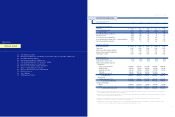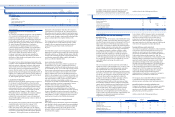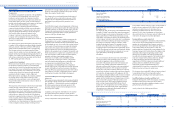Humana 1999 Annual Report Download - page 19
Download and view the complete annual report
Please find page 19 of the 1999 Humana annual report below. You can navigate through the pages in the report by either clicking on the pages listed below, or by using the keyword search tool below to find specific information within the annual report.
HU M A N A IN C ./
C O N S O L I D ATED BALANCE SHEETS
(In millions, except share amounts)
December 31, 1999 1998
A S S E T S
Current assets:
Cash and cash equivalents $ 978 $ 913
Marketable securities 1,507 1,594
Premiums receivable, less allowance for doubtful accounts
of $61 in 1999 and $62 in 1998 225 276
Deferred income taxes 161 129
Other 193 207
Total current assets 3,064 3,119
Property and equipment, net 418 433
Other assets:
Long-term marketable securities 253 305
Cost in excess of net assets acquired 806 1,188
Deferred income taxes 54 64
Other 305 387
Total other assets 1,418 1,944
Total assets $ 4,900 $ 5,496
L I A B I LI TI E S A ND ST O C K H O LD E R S ’ E Q U I T Y
Current liabilities:
Medical and other expenses payable $ 1,432 $ 1,470
Trade accounts payable and accrued expenses 392 395
Book overdraft 215 234
Unearned premium revenues 349 294
Accrued losses on asset sales 90
Commercial paper 686 730
Total current liabilities 3,164 3,123
Long-term medical and other expenses payable 324 438
Professional liability and other obligations 144 154
Debt 93
Total liabilities 3,632 3,808
Commitments and contingencies
Stockholders’ equity:
Preferred stock, $1 par; authorized 10,000,000 shares; none issued
Common stock, $0.16 2/3 par; authorized 300,000,000 shares; issued and outstanding
167,514,710 shares — 1999 and 167,515,362 shares — 1998 28 28
Capital in excess of par value 899 903
Deferred compensation — restricted stock (2) (9)
Retained earnings 371 753
Accumulated other comprehensive (loss) income (28) 13
Total stockholders’ equity 1,268 1,688
Total liabilities and stockholders’ equity $ 4,900 $ 5,496
Th e accompanying notes are an integral part of the consolidated financi al statements.
35
that require contingency plan development. The six major
functional areas are: providers, service centers, suppliers
and vendors, customers and brokers, banking and finance
and legal services.
While the Company presently believes that the timely
completion of its Year 2000 project limited the exposure, so
that the Year 2000 issue has not posed material operational
problems, the Company recognizes that it does not control
third party constituents. If these third party organizations
have failures related to the Year 2000 century change
and/or fail to properly implement appropriate contingency
plans, Year 2000 failures may result. These failures could
potentially have a material adverse impact on the
Company’s financial position, results of operations and
cash flows.
L E G A L PR OC E E D IN G S
During 1999, six purported class action complaints have
been filed against the Company and certain of its current
and former directors and officers claiming that the
Company and the individual defendants knowingly or
recklessly made false or misleading statements in press
releases and public filings concerning the Company’s
financial condition. All seek money damages of
unspecified amounts.
Since October 1999, the Company has received purported
class action complaints alleging, among other things, that
Humana intentionally concealed from its members
information concerning the various ways Humana decides
what claims will be paid, what procedures will be deemed
medically necessary, and what criteria and procedures are
used to determine the extent and type of their coverage.
The complaints also allege that Humana concealed from
members the existence of direct financial incentives to
treating physicians and other health care providers to deny
coverage. The complaints, generally, do not allege that any
member was denied coverage for services that should have
been covered but, instead, claim that Humana provided
health insurance benefits of lesser value than promised. All
seek money damages of unspecified amounts. The
Company has requested to consolidate these complaints to
a single court.
The Company believes the allegations in all of the above
complaints are without merit and intends to pursue the
defense of the actions vigorously.
On January 4, 2000, a jury in Palm Beach County, Florida,
issued a verdict against Humana Health Insurance
Company of Florida, Inc., awarding $79 million to Mark
Chipps, an insured who had sued individually and on
behalf of his minor daughter. The claim arose from the
removal of the child from a case management program
which had provided her with benefits in excess of those
available under her policy. The award included $78 million
for punitive damages, $1 million for emotional distress and
$28,000 for contractual benefits. The Company is in the
process of appealing the verdict.
During 1999, the Company reached an agreement in
principle with the United States Department of Justice and
the Department of Health and Human Services on a $15
million settlement relating to Medicare premium
overpayments. The settlement is expected to be paid some-
time during 2000. The Company had previously established
adequate liabilities for the resolution of these issues and,
therefore, the settlement did not have a material impact on
the Company’s financial position or results of operations.
Damages for claims for personal injuries and medical
benefit denials are usual in the Company’s business.
Personal injury and medical benefit denial claims are
covered by insurance from the Company’s wholly owned
captive insurance Subsidiary and excess carriers, except to
the extent that claimants seek punitive damages, in states
which prohibit insurable coverage for punitive damages.
In connection with the Chipps case, the excess carriers have
preliminarily indicated that they believe no coverage may
be available for a punitive damages award.
During the ordinary course of its business, the Company is
or may become subject to pending or threatened litigation
or other legal actions. Management does not believe that
any pending and threatened legal actions against the
Company or audits by agencies will have a material
adverse effect on the Company’s financial position or
results of operations.
R E C E N T LY I SS UE D A CC O U N T I N G P R O NO U N CE M E NT S
In June 1998, the Financial Accounting Standards Board
issued Statement of Financial Accounting Standards No.
133, “Accounting for Derivative Instruments and Hedging
Activities” (“SFAS No. 133”). In general, SFAS No. 133
requires that all derivatives be recognized as either assets or
liabilities in the balance sheet at their fair value, and sets
forth the manner in which gains or losses thereon are to be
recorded. The treatment of such gains or losses is
dependent upon the type of exposure, if any, for which the
derivative is designated as a hedge. This standard is
effective for the Company’s financial statements beginning
January 1, 2001, with early adoption permitted.
Management of the Company anticipates that the adoption
of SFAS No. 133 on January 1, 2001 will not have a material
impact on the Company’s financial position, results of
operations or cash flows.
34
HU M A N A IN C .
MANAGEMENT’S DI SCUSSION AN D A NA LYSIS OF FINANCIAL CONDITION AND RESULTS O F O PERATIONS
























